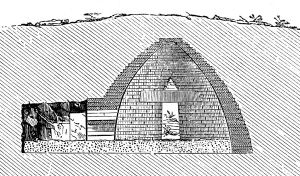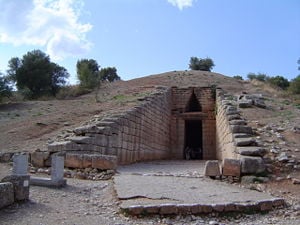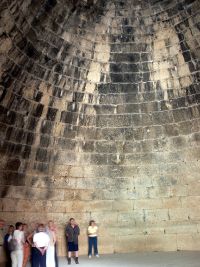Difference between revisions of "Beehive tomb" - New World Encyclopedia
m |
|||
| Line 1: | Line 1: | ||
| − | {{Claimed}} | + | {{Claimed}}{{Started}} |
[[Category:Politics and social sciences]] | [[Category:Politics and social sciences]] | ||
[[Category:Anthropology]] | [[Category:Anthropology]] | ||
| Line 5: | Line 5: | ||
[[Image:Atreus-2.jpg|right|thumb|Cross section of a beehive tomb ([[Treasury of Atreus]])]] | [[Image:Atreus-2.jpg|right|thumb|Cross section of a beehive tomb ([[Treasury of Atreus]])]] | ||
[[Image:Treasure_of_Atreus.jpg|right|thumb|[[Dromos]] entrance to the [[Treasury of Atreus]]]] | [[Image:Treasure_of_Atreus.jpg|right|thumb|[[Dromos]] entrance to the [[Treasury of Atreus]]]] | ||
| − | '''Beehive tombs''', also known as '''Tholos tombs''' (plural '''tholoi'''), are a monumental Late [[Bronze Age]] development of either the [[Mycenaean chamber tomb]]s or tumulus burials dating to the Middle | + | '''Beehive tombs''', also known as '''Tholos tombs''' (plural '''tholoi'''), are a monumental Late [[Bronze Age]] development of either the [[Mycenaean chamber tomb]]s or tumulus burials dating to the Middle Bronze Age. |
| − | + | The term '''chamber tomb''' is used to refer to a form of mortuary architecture in use in the Late Bronze Age of the areas under the cultural influence of the [[Aegean civilization|Aegean]]. | |
| + | |||
| + | The tombs are rock cut and show a tripartite structure (chamber, stomion and dromos), often with additional niches and side chambers. Extensive cemeteries have been found in all parts of Greece having [[Mycenae]]an influences. For about 500 years from 1600 B.C.E. to 1100 B.C.E. they were the most widespread of mortuary structures. | ||
| + | |||
| + | After about 1500 B.C.E., beehive [[tomb]]s became more widespread. They were built as corbelled arches, layers of stone placed closer together as the arch tapers toward the top of the tomb. The tombs usually contain more than one [[burial]], in various places in the tomb either on the floor, in pits and cists or on stone-built or rock-cut benches, and with various [[grave goods]]. After a burial, the entrance to the tomb was filled in with [[soil]], leaving a small mound with most of the tomb underground. | ||
The tripartite structure of the tombs is not always evident in the earliest mainland examples (for example at [[Voidhokoilia]]) but by the time the architectural type had left [[Messenia]] the separation into chamber, stomion and dromos was fixed. The chamber is always built in [[masonry]], even in the earliest examples, as is the stomion or entrance-way, which provided an opportunity for conspicuous demonstration of wealth. The dromos was often just cut from the [[bedrock]], even in some of the earlier examples at [[Mycenae]] itself. In later examples, all three parts were constructed of fine [[ashlar]] masonry. | The tripartite structure of the tombs is not always evident in the earliest mainland examples (for example at [[Voidhokoilia]]) but by the time the architectural type had left [[Messenia]] the separation into chamber, stomion and dromos was fixed. The chamber is always built in [[masonry]], even in the earliest examples, as is the stomion or entrance-way, which provided an opportunity for conspicuous demonstration of wealth. The dromos was often just cut from the [[bedrock]], even in some of the earlier examples at [[Mycenae]] itself. In later examples, all three parts were constructed of fine [[ashlar]] masonry. | ||
The abundance of such tombs, often with more than one being associated with a settlement during one specific time period, may indicate that their use was not confined to the ruling [[monarchy]] only, although the sheer size and therefore the outlay required for the larger tombs (ranging from about 10 meters to about 15 meters in diameter and height) would argue in favour of royal commissions. The larger tombs contained amongst the richest finds to have come from the Late Bronze Age of Mainland Greece, despite the tombs having been pillaged both in [[antiquity]] and more recently. | The abundance of such tombs, often with more than one being associated with a settlement during one specific time period, may indicate that their use was not confined to the ruling [[monarchy]] only, although the sheer size and therefore the outlay required for the larger tombs (ranging from about 10 meters to about 15 meters in diameter and height) would argue in favour of royal commissions. The larger tombs contained amongst the richest finds to have come from the Late Bronze Age of Mainland Greece, despite the tombs having been pillaged both in [[antiquity]] and more recently. | ||
| + | [[Image:Banditaccia1.jpg|thumb|250px|left|View of the [[Etruscan civilization|Etruscan]] necropolis of Banditaccia, in [[Cerveteri]], Italy.]] | ||
| + | There are also recorded [[Etruscan civilization|Etruscan]] tombs at a necropolis at [[Banditaccia]] from the 6th and 7th Centuries B.C.E. having an external appearance similar to a beehive. The interiors are decorated and furnished as Etruscan dwellings. | ||
| − | + | ==Treasury of Atreus== | |
| + | [[Image:07Mykene Atreus02.jpg|thumb|left|200 px|Inside the [[Treasury of Atreus]]]] | ||
| + | The '''Treasury of [[Atreus]]''' is an impressive "tholos" tomb at [[Mycenae]], Greece (on the Panagitsa Hill) constructed around 1250 B.C.E. The [[lintel (architecture)|lintel stone]] above the doorway weighs 120 tons. The tomb was used for an unknown period of time. With an interior height of 13.5m and a diameter of 14.5m,<ref name = "Structurae.de: Treasury of Atreus"> Structurae.de: [http://en.structurae.de/structures/data/index.cfm?ID=s0003185 Treasury of Atreus]</ref> it was the tallest and widest dome in the world for over a thousand years until construction of the [[Temple of Mercury (Baiae)|Temple of Mercury]] in [[Baiae]]. | ||
==Beehive tombs in Oman== | ==Beehive tombs in Oman== | ||
| − | The earliest stone-built tombs which can be called 'beehive', are in Oman, built of stacked flat stones which occur in nearby geological formations. They date to between 3,500 and 2,500 years | + | The earliest stone-built tombs which can be called 'beehive', are in Oman, built of stacked flat stones which occur in nearby geological formations. They date to between 3,500 and 2,500 years B.C.E., to a period when the Arabian peninsula was subject to much more rainfall than now, and supported a flourishing civilisation in what is now desert, to the west of the mountain range along the Gulf of Oman. No burial remains have ever been retrieved from these 'tombs', though there seems no other purpose for their building. They have only superficial similarities with the Aegean tombs (circular shape) as they are built entirely above ground level and do not share the same tripartite structure - the entrances are usually an undifferentiated part of the circular walling of the tomb. |
| − | + | ==References== | |
| + | <references/> | ||
| − | + | ==External links== | |
| − | == | + | * [http://www.huntfor.com/arthistory/ancient/aegean_art.htm Mycenaean tholos tombs paintings] |
| − | *[ | + | * {{structurae|id=s0003185|title=Treasury of Atreus}} |
| + | *[http://www.vGreece.com/index.php?entry=entry061018-191233 Treasury of Atreus] 360° Interactive virtual tour | ||
{{credits|Beehive_tomb|145459839|Mycenaean_chamber_tomb|141057997|Treasury_of_Atreus|145317144}} | {{credits|Beehive_tomb|145459839|Mycenaean_chamber_tomb|141057997|Treasury_of_Atreus|145317144}} | ||
Revision as of 16:59, 11 August 2007
Beehive tombs, also known as Tholos tombs (plural tholoi), are a monumental Late Bronze Age development of either the Mycenaean chamber tombs or tumulus burials dating to the Middle Bronze Age.
The term chamber tomb is used to refer to a form of mortuary architecture in use in the Late Bronze Age of the areas under the cultural influence of the Aegean.
The tombs are rock cut and show a tripartite structure (chamber, stomion and dromos), often with additional niches and side chambers. Extensive cemeteries have been found in all parts of Greece having Mycenaean influences. For about 500 years from 1600 B.C.E. to 1100 B.C.E. they were the most widespread of mortuary structures.
After about 1500 B.C.E., beehive tombs became more widespread. They were built as corbelled arches, layers of stone placed closer together as the arch tapers toward the top of the tomb. The tombs usually contain more than one burial, in various places in the tomb either on the floor, in pits and cists or on stone-built or rock-cut benches, and with various grave goods. After a burial, the entrance to the tomb was filled in with soil, leaving a small mound with most of the tomb underground.
The tripartite structure of the tombs is not always evident in the earliest mainland examples (for example at Voidhokoilia) but by the time the architectural type had left Messenia the separation into chamber, stomion and dromos was fixed. The chamber is always built in masonry, even in the earliest examples, as is the stomion or entrance-way, which provided an opportunity for conspicuous demonstration of wealth. The dromos was often just cut from the bedrock, even in some of the earlier examples at Mycenae itself. In later examples, all three parts were constructed of fine ashlar masonry.
The abundance of such tombs, often with more than one being associated with a settlement during one specific time period, may indicate that their use was not confined to the ruling monarchy only, although the sheer size and therefore the outlay required for the larger tombs (ranging from about 10 meters to about 15 meters in diameter and height) would argue in favour of royal commissions. The larger tombs contained amongst the richest finds to have come from the Late Bronze Age of Mainland Greece, despite the tombs having been pillaged both in antiquity and more recently.
There are also recorded Etruscan tombs at a necropolis at Banditaccia from the 6th and 7th Centuries B.C.E. having an external appearance similar to a beehive. The interiors are decorated and furnished as Etruscan dwellings.
Treasury of Atreus
The Treasury of Atreus is an impressive "tholos" tomb at Mycenae, Greece (on the Panagitsa Hill) constructed around 1250 B.C.E. The lintel stone above the doorway weighs 120 tons. The tomb was used for an unknown period of time. With an interior height of 13.5m and a diameter of 14.5m,[1] it was the tallest and widest dome in the world for over a thousand years until construction of the Temple of Mercury in Baiae.
Beehive tombs in Oman
The earliest stone-built tombs which can be called 'beehive', are in Oman, built of stacked flat stones which occur in nearby geological formations. They date to between 3,500 and 2,500 years B.C.E., to a period when the Arabian peninsula was subject to much more rainfall than now, and supported a flourishing civilisation in what is now desert, to the west of the mountain range along the Gulf of Oman. No burial remains have ever been retrieved from these 'tombs', though there seems no other purpose for their building. They have only superficial similarities with the Aegean tombs (circular shape) as they are built entirely above ground level and do not share the same tripartite structure - the entrances are usually an undifferentiated part of the circular walling of the tomb.
ReferencesISBN links support NWE through referral fees
- ↑ Structurae.de: Treasury of Atreus
External links
- Mycenaean tholos tombs paintings
- Treasury of Atreus in the Structurae database
- Treasury of Atreus 360° Interactive virtual tour
Credits
New World Encyclopedia writers and editors rewrote and completed the Wikipedia article in accordance with New World Encyclopedia standards. This article abides by terms of the Creative Commons CC-by-sa 3.0 License (CC-by-sa), which may be used and disseminated with proper attribution. Credit is due under the terms of this license that can reference both the New World Encyclopedia contributors and the selfless volunteer contributors of the Wikimedia Foundation. To cite this article click here for a list of acceptable citing formats.The history of earlier contributions by wikipedians is accessible to researchers here:
The history of this article since it was imported to New World Encyclopedia:
Note: Some restrictions may apply to use of individual images which are separately licensed.


